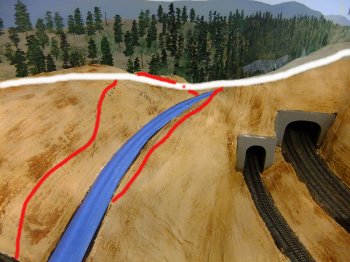
|
This cluster of tracks which come together on the back side of the helix scene. On the left, covered by blue tape, is the main line coming down from Summit. The other single track is the lower level "show loop", aka the Modoc Line. On the far right are the main line and Palisades siding, about half way down the helix. Clearly, there are way too many tracks visible here to make a credible scene of a single track railroad through the mountains. The challenge is to separate them visually.
As we've often stated in building the P&E, the first step in creating a great scene is to consider what the land forms looked like before the railroad came. The white line represents a ridge between two drainage's with a bit of a saddle in the middle. The railroad punched through this saddle and made cuts along the red lines.
The lower tracks (Modoc and helix/siding) will require some compromises, but we figure with enough trees and brush, we can break them out of the "spaghetti bowl" look |
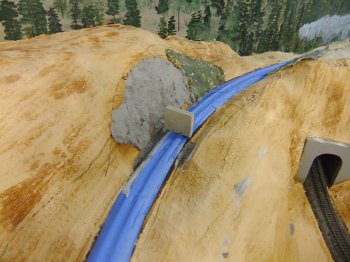
|
The first step was to slap some rock castings on the cuts. In this picture, we have one rock casting already in place with another, in the green mold, starting to set up. The gray block on the track is a 2 1/4" wide piece of homasote with grooves cut in it to fit over the rails and tape. If any protuberance of a rock casting fouls this block, it's quickly chipped away before the plaster completely hardens. |
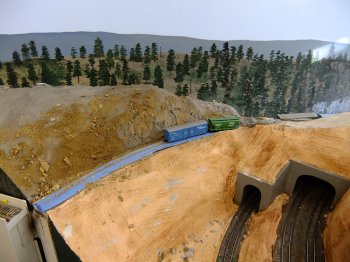
|
Finish plaster was applied to the land forms above and to the left of the rock castings and then a natural dirt/gravel mixture was literally thrown at the soft plaster and hardened rock castings. Much of the thrown material stuck and will be further glued down with dilute white glue. |
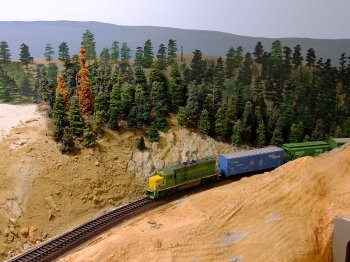 |
Before long, John got back to work creating forest floor clutter and trees above the cut. |
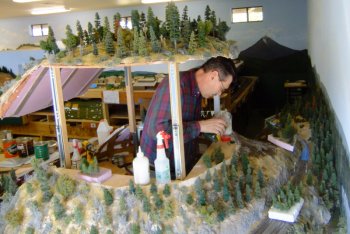
|
Parts of the scene were inaccessible from either aisle,so John resorted to lifting the pop-up and working from inside the helix. |
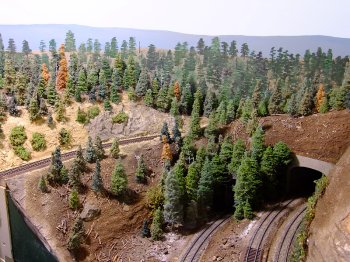
|
The scene in the upper half of this image is mostly done. Attention was paid to blending the foreground colors with the backdrop and making the transition between the 3 dimensional scene and the backdrop as inconspicuous as possible.
In the lower half of this picture a thick grove of trees obscures one tunnel portal while forest floor litter (sifted debris from the floor of Larry's wood shed and small twigs prepared by E. Don) lie on the hillside above the tracks. |
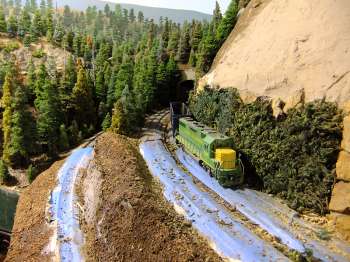
|
The steep land form to the right of this train gave us pause. Short of taking a hammer to it and reducing the slope, (which would have cut down on needed work space inside the mountain pop-up) there weren't a lot of options. Rock castings would stick out too far and Larry wanted this element of the scene to blend into the forest from most angles. Even very flat trees would be a problem. So, Larry took some moss he'd gathered from rocks and trees up in the woods, sprayed it dark green, flocked it with fine dark green ground foam and glued it to the land form. At first it looked kind of hokey, but after darker forest floor litter and trees were added above and on the berm between the two sets of tracks, the effect started to work. |
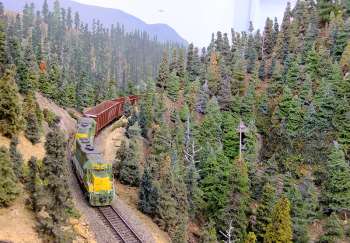 |
Success! The three lower tracks are effectively hidden from view in this shot of the main line above Palisades.
|
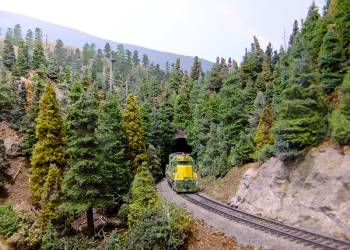
|
And the middle loop track (aka Modoc Line) has been visually isolated from the helix tracks just a few inches to the right and the main line a few more inches above and to the left.
Also, the tunnel portal has been de-emphasized with a couple of "dun-lop" trees over the opening. |
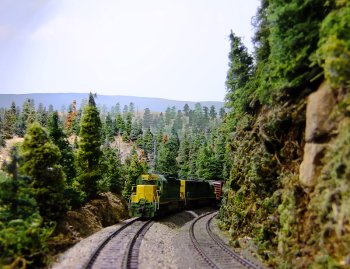 |
Even the helix tracks appear miles from any other trackage when viewed from this low angle.
|
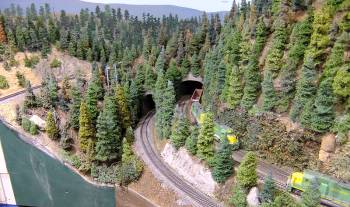 |
In this overall view of the nearly completed scene one can still see the four tracks but, the "spaghetti bowl" effect is diminished. Lesson learned: enough trees and brush and one can hide almost anything. |

